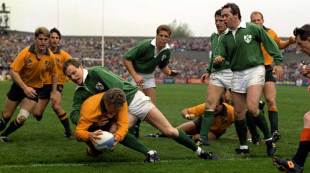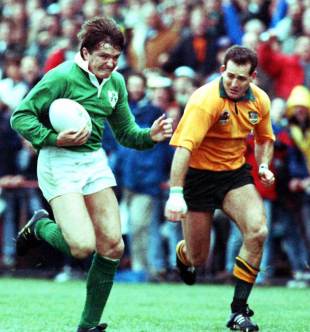|
Ireland 18-19 Australia, Rugby World Cup
Lynagh silences Lansdowne Road
Richard Seeckts
October 20, 1991

Michael Lynagh prepares to ground the ball
© PA Photos Enlarge
Ireland came desperately close to pulling off a shock win over favourites Australia that would have passed into rugby folklore. So close, in fact, that their heroic failure has passed into rugby folklore anyway. The name of Gordon Hamilton is still celebrated for his try that put Ireland 18-15 ahead with six minutes remaining, and on course for a semi-final against New Zealand. However, Michael Lynagh's last gasp try dashed Irish hopes and Australia went on to win the second Rugby World Cup. Ireland have a history of spoiling visitors' parties at Lansdowne Road, but no-one expected them to keep the Wallabies at bay for 80 minutes. Man for man, Australia were stronger and more dynamic in every department. Collectively, their superiority and experience meant that Irish fans arrived in hope, not expectation, and would have departed happy with anything better than a good thumping. It was Irish captain, Philip Matthews, who started the thumping, his right hook on Wallaby No.8 Willy Ofahengaue in the first minute sparking a fearsome brawl. Referee Jim Fleming, after warning everyone in sight, told the captains that too many players had been involved for him to send anyone off. Steam duly let off all round, a tense but cleanly contested game of rugby broke out. Both packs of forwards contained the experience needed for a successful World Cup campaign, a young John Eales being the joey among the Wallabies. In the backs, only Brendan Mullin among the Irish had international history to compare with Nick Farr-Jones, Lynagh, Tim Horan, Jason Little and David Campese. Top of the bill, Campese was expected to put on a show and didn't disappoint. Showing deft footwork and terrific pace over 30 metres, he opened the scoring after 16 minutes, going over under the posts, leaving an easy conversion for Lynagh. Lynagh assumed the captaincy when Farr-Jones left the field injured midway through the first half. For the hosts, Ralph Keyes, whose eight match international career boasts his being the leading points scorer in the 1991 World Cup, knocked over a couple of penalties and the teams changed ends level at 6-6. Australia were dominant but Keyes' kicking never let them pull ahead as expected. After the break, a Lynagh penalty was matched by a Keyes dropped goal before Campese scored his second try, courtesy of a smart loop by Little. A six point margin going into the final quarter was no comfort zone for Australia as Ireland continued to snap at their heels. Another Keyes penalty narrowed the gap to three points and all Ireland dared to dream. Ireland had a scrum 30 metres out from their line and wide on the right. Rob Saunders flipped the ball out to the three quarters, who were joined by full-back Jim Staples in mid-field. Staples put a perfectly weighted grubber kick behind Australia's defence and the chase was on. Jack Clarke, on Ireland's left wing in place of the injured speedster Keith Crossan, tussled with Campese as they both gave chase. The Australian lost his footing, allowing Clarke to gather the ball and remain on his feet while Hamilton was charging up on his inside. Wallaby full-back Marty Roebuck tackled Clarke, who stayed upright just long enough to offload to Hamilton, now going at full tilt for the line from 40 metres out.

Gordon Hamilton tears down the wing
© PA Photos
Enlarge
Campese quickly regained his feet and gave chase into the 22 before giving up. Meanwhile Rob Egerton had come on a long diagonal run from his left wing and put in one final desperate tackle on Hamilton four metres from the line. Down went Hamilton, but his momentum carried him over for the score. Lansdowne Road erupted. Dozens of spectators ran on to congratulate Hamilton, young boys among them, while one in a red coat stood over the crumpled Egerton, doubtless offering unwelcome advice. With little ado, Keyes added the conversion. Ireland led 18-15 with six long minutes remaining. Australia had to score or fly home next day. If they could draw level with a penalty or a dropped goal, there would be extra time. Referee Fleming awarded Australia a scrum 10 metres from Ireland's line with two minutes left. It was perfect territory for the dropped goal that would give them another 20 minutes to finish the job. Lynagh decided to eschew that option and go for the try instead. From the scrum, the ball was flung right through the backs and taken by Campese 20 metres out and searching for a hat-trick. Mullin brought him down short but the ball popped up perfectly for Lynagh, looping round his winger, to collect it and flop over in the corner, shattering Irish dreams. The crowd, frantically excited moments before, went silent. Disbelief, shock, reality. The match Ireland had come so close to snatching had been snatched back. Dublin partied that night as it always does on a rugby night and, knowing they had come so close to winning an epic quarter-final, the crowd threw its weight behind Australia for the semi-final at Lansdowne Road a week later, when New Zealand were seen off 16-6. Hamilton's moment of greatness is remembered widely and fondly, but ultimately this defeat ended an era in Irish rugby. They finished the 1992 Five Nations Championship with the wooden spoon and, within a year, half the team's international careers were finished. © ESPN Sports Media Ltd.
| |||||||||||||||
Live Sports
Communication error please reload the page.
-
Football
-
Cricket
-
Rugby
-
- Days
- Hrs
- Mins
- Secs
F1 - Abu Dhabi GP
Abu Dhabi Grand Prix December 11-131. Max Verstappen ()
2. Valtteri Bottas (Mercedes)
3. Lewis Hamilton (Mercedes)
4. Alexander Albon ()
5. Lando Norris ()
6. Carlos Sainz Jr ()
-
ESPNOtherLive >>
Golf - Houston Open
Snooker - China Open
Tennis - Miami Open

